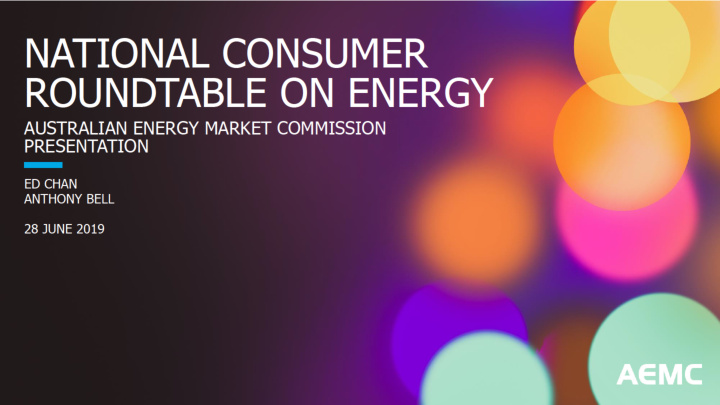



We have listed the priority areas of reform that we are focusing on Generator access and Shift from large geographically concentrated transmission pricing to small geographically dispersed generation Services previously provided for free not System security necessarily provided by new generation Integrating Increased adoption of small-scale solar and distributed energy energy storage technologies resources Digitalisation of Increased adoption of digital technologies energy supply Aligning financial More variable demand and supply creating incentives with the volatility physical needs 6
We have met with a number of stakeholders and held two workshops • Public workshop on the incentive framework (March 2019) • “DEIP Dive” co -hosted with ARENA on DER integration (June 2019) • What feedback did we get? • DER and how they are integrated in the electricity system is a top priority issue • It is important to get the incentive framework right for network businesses, but recent changes has made this a lower priority issue 7
2019 Review – what will we focus on? • Consumers – and how they use the electricity system • How can the regulatory framework enable consumers to get the most value out of their investment in DER • How do we harness the ‘individual investment’ to provide benefits to all consumers • Set out a ‘roadmap’ to get us there 9
What have we heard from stakeholders? • Consumers want DER – this is going to • Exports with no constraints – some continue, don’t stand in their way, work jurisdictional governments are thinking with them about it • DER can do lots of good things , but • Equity issue – the haves vs have nots, their capabilities are not fully utilised – the early adopters vs the late comers current framework and business operation not conducive • Charging/tariff arrangements : • General consensus: something needs • DER exporting is causing technical to change issues for the networks – restricting exports is the one of the most common management tool, but this causes issues 10
What will the ‘roadmap’ look like? The future How will we do it? • Not define ‘the future’ • The future is DER – and lots of it • The framework needs to accommodate • DER is more than PV and batteries multiple paths • EVs, DR/DM … plus more • When they are used/controlled in a • Consider all the work done (or being coordinated manner done) • by all organisations • Consumer centric and users driven • at all levels of the system • How will consumers use DER in the future? • A coordinated effort , no one body can do this alone, but avoid duplications • What expectations do they have? • Recommend reforms where necessary 11
What are some of the key issues? The role of networks in a high DER ‘Enablers’ future • DNSPs’ understanding and visibility of their LV networks • The changing nature of the electricity system • AER’s consideration of DNSPs’ proposal • Moving from one-way to two-way for expenditure for DER enablers traffic • Platform for multiple services • Smart meters • Meeting customers’ expectations • Consumption tariff reform • Also governments’ – they provide subsidies to encourage more uptake of PV and batteries 12
NER Clause 6.1.4 – a potential area for reform?? Issues with consumption only pricing Potential solutions? • Allowing DNSPs to apply a ‘use of system • Equity issues charge’ is a potential solution proposed by a few stakeholder groups • Revenue recovery for networks • Not maximising DER’s potential • “Consumption only charging is not going to be fit for purpose in a high DER future” 13
NER Clause 6.1.4 – Will export charging solve all ills? • Export charging cannot be done on its own • Access, connections, charging are interrelated • Export charging alone won’t address all the equity issues • The role of networks in a high DER future is important • Providing services to enable customers to use DER in the way they want • Different (or new) networks services will have implications on: • Access to the grid, nature of connection arrangements • Levels and standard of services • DNSPs’ revenue requirements 14
What about consumer engagement? • Uptake of DER is consumer led • Consumer preferences will be an important input • Revenue determination process is moving more to the negotiated outcome process • Complexity of the rules/framework presents a barrier to efficient engagement • Do we need to better integrate or incentivise consumer engagement in the regulatory framework? 15
What about DSO? • Is there a difference between DSO and DMO? • DSO is a potential solution • The role of DNSPs are crucial (again) • Some considerations • Consistency in standards – rail gauge issues • What about difference between regions or within a network? • Implementation costs 16
Office address Level 6, 201 Elizabeth Street Sydney NSW 2000 ABN: 49 236 270 144 Postal address PO Box A2449 Sydney South NSW 1235 T (02) 8296 7800 F (02) 8296 7899
What is our approach to the review? • A regular and ongoing platform to monitor changes and developments in the national electricity market • Working with all stakeholders of the energy sector to identify and understand risks and opportunities for reform • If there is a need for reform … The economic regulatory • Recommend changes to the COAG Energy Council framework needs to deliver the best outcomes for consumers • Progress recommendations tasked by officials and other review bodies 21
We would like to hear your views • The annual economic review is an important and structured mechanism to examine issues and consider potential reforms if necessary • We need to broaden the discussion beyond regulators and network businesses • What are your views on the issues we are considering currently? • Are there other issues we should be thinking about? 22
Recommend
More recommend